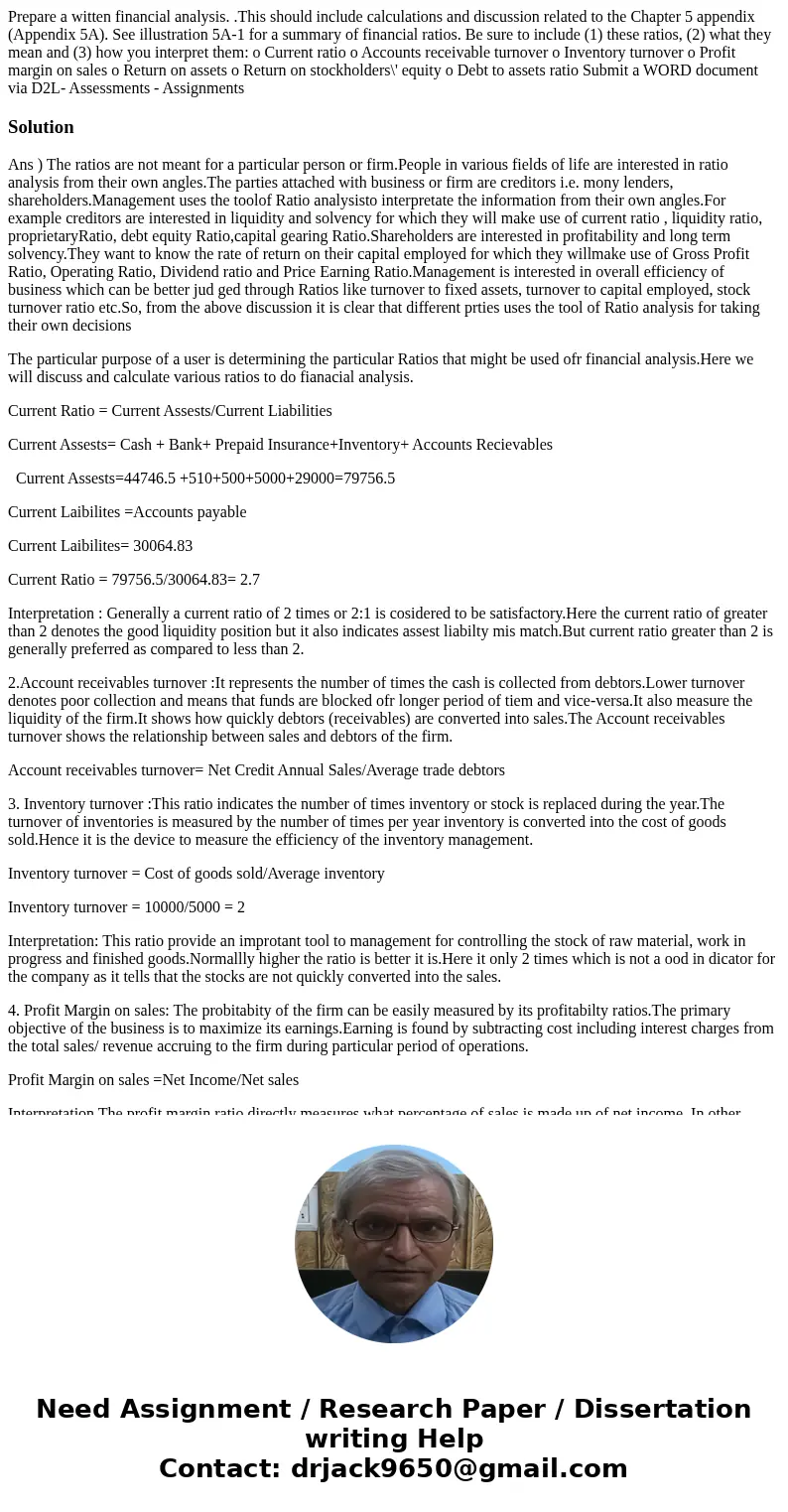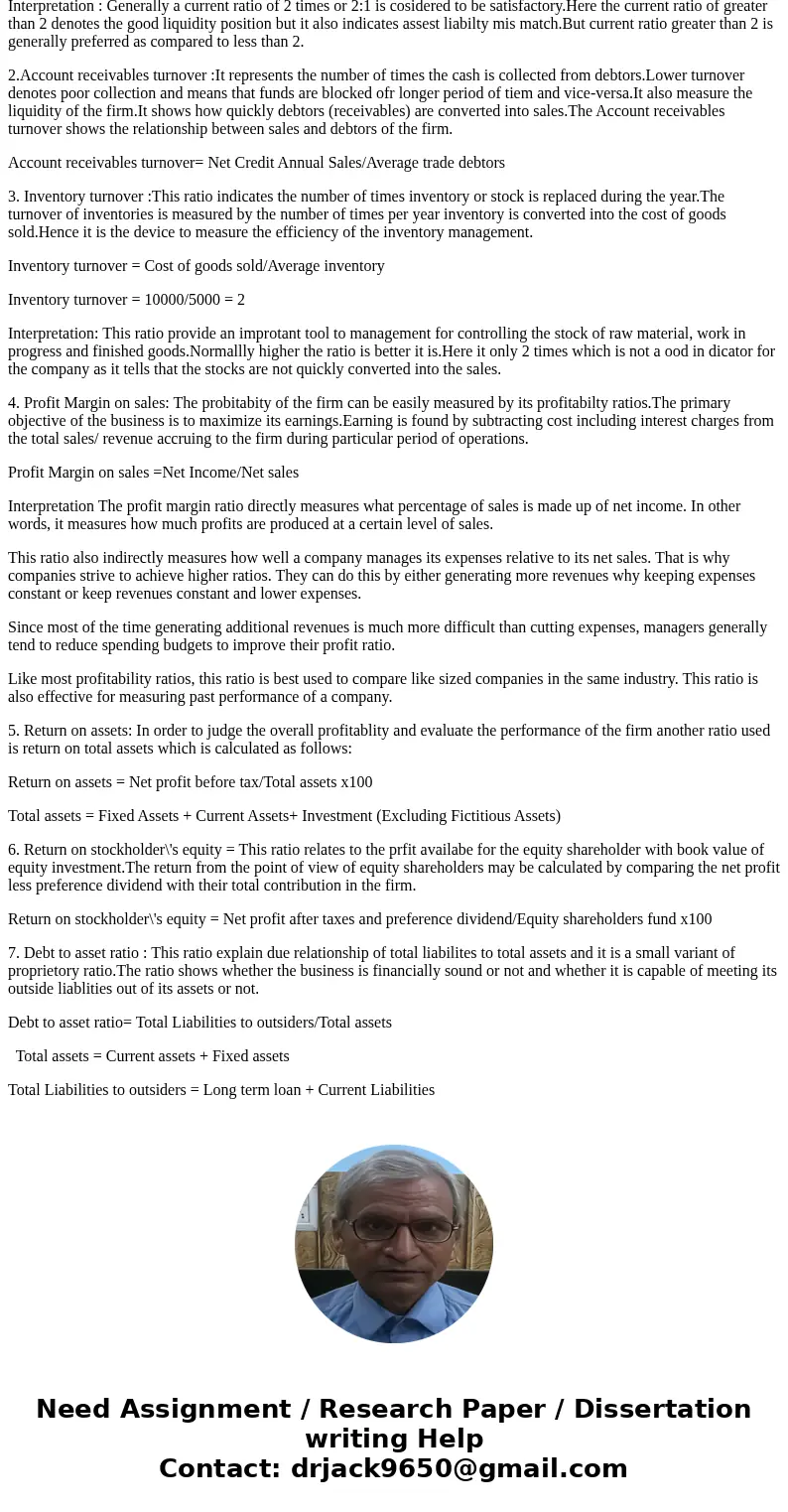Prepare a witten financial analysis This should include calc
Solution
Ans ) The ratios are not meant for a particular person or firm.People in various fields of life are interested in ratio analysis from their own angles.The parties attached with business or firm are creditors i.e. mony lenders, shareholders.Management uses the toolof Ratio analysisto interpretate the information from their own angles.For example creditors are interested in liquidity and solvency for which they will make use of current ratio , liquidity ratio, proprietaryRatio, debt equity Ratio,capital gearing Ratio.Shareholders are interested in profitability and long term solvency.They want to know the rate of return on their capital employed for which they willmake use of Gross Profit Ratio, Operating Ratio, Dividend ratio and Price Earning Ratio.Management is interested in overall efficiency of business which can be better jud ged through Ratios like turnover to fixed assets, turnover to capital employed, stock turnover ratio etc.So, from the above discussion it is clear that different prties uses the tool of Ratio analysis for taking their own decisions
The particular purpose of a user is determining the particular Ratios that might be used ofr financial analysis.Here we will discuss and calculate various ratios to do fianacial analysis.
Current Ratio = Current Assests/Current Liabilities
Current Assests= Cash + Bank+ Prepaid Insurance+Inventory+ Accounts Recievables
Current Assests=44746.5 +510+500+5000+29000=79756.5
Current Laibilites =Accounts payable
Current Laibilites= 30064.83
Current Ratio = 79756.5/30064.83= 2.7
Interpretation : Generally a current ratio of 2 times or 2:1 is cosidered to be satisfactory.Here the current ratio of greater than 2 denotes the good liquidity position but it also indicates assest liabilty mis match.But current ratio greater than 2 is generally preferred as compared to less than 2.
2.Account receivables turnover :It represents the number of times the cash is collected from debtors.Lower turnover denotes poor collection and means that funds are blocked ofr longer period of tiem and vice-versa.It also measure the liquidity of the firm.It shows how quickly debtors (receivables) are converted into sales.The Account receivables turnover shows the relationship between sales and debtors of the firm.
Account receivables turnover= Net Credit Annual Sales/Average trade debtors
3. Inventory turnover :This ratio indicates the number of times inventory or stock is replaced during the year.The turnover of inventories is measured by the number of times per year inventory is converted into the cost of goods sold.Hence it is the device to measure the efficiency of the inventory management.
Inventory turnover = Cost of goods sold/Average inventory
Inventory turnover = 10000/5000 = 2
Interpretation: This ratio provide an improtant tool to management for controlling the stock of raw material, work in progress and finished goods.Normallly higher the ratio is better it is.Here it only 2 times which is not a ood in dicator for the company as it tells that the stocks are not quickly converted into the sales.
4. Profit Margin on sales: The probitabity of the firm can be easily measured by its profitabilty ratios.The primary objective of the business is to maximize its earnings.Earning is found by subtracting cost including interest charges from the total sales/ revenue accruing to the firm during particular period of operations.
Profit Margin on sales =Net Income/Net sales
Interpretation The profit margin ratio directly measures what percentage of sales is made up of net income. In other words, it measures how much profits are produced at a certain level of sales.
This ratio also indirectly measures how well a company manages its expenses relative to its net sales. That is why companies strive to achieve higher ratios. They can do this by either generating more revenues why keeping expenses constant or keep revenues constant and lower expenses.
Since most of the time generating additional revenues is much more difficult than cutting expenses, managers generally tend to reduce spending budgets to improve their profit ratio.
Like most profitability ratios, this ratio is best used to compare like sized companies in the same industry. This ratio is also effective for measuring past performance of a company.
5. Return on assets: In order to judge the overall profitablity and evaluate the performance of the firm another ratio used is return on total assets which is calculated as follows:
Return on assets = Net profit before tax/Total assets x100
Total assets = Fixed Assets + Current Assets+ Investment (Excluding Fictitious Assets)
6. Return on stockholder\'s equity = This ratio relates to the prfit availabe for the equity shareholder with book value of equity investment.The return from the point of view of equity shareholders may be calculated by comparing the net profit less preference dividend with their total contribution in the firm.
Return on stockholder\'s equity = Net profit after taxes and preference dividend/Equity shareholders fund x100
7. Debt to asset ratio : This ratio explain due relationship of total liabilites to total assets and it is a small variant of proprietory ratio.The ratio shows whether the business is financially sound or not and whether it is capable of meeting its outside liablities out of its assets or not.
Debt to asset ratio= Total Liabilities to outsiders/Total assets
Total assets = Current assets + Fixed assets
Total Liabilities to outsiders = Long term loan + Current Liabilities


 Homework Sourse
Homework Sourse